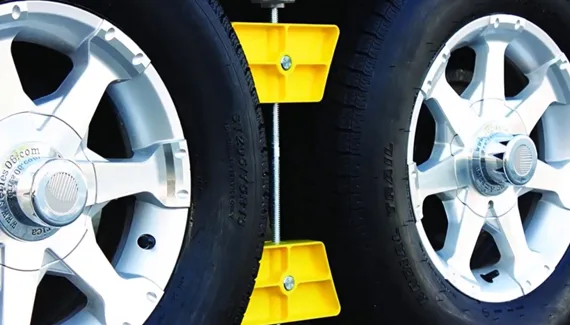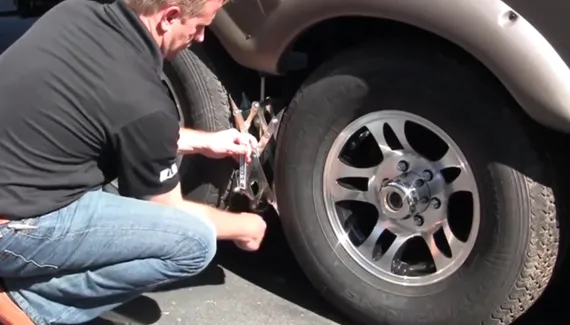Last Updated on April 13, 2023
When traveling and staying in unfamiliar places, it’s imperative to be safe and secure. Chocking your trailer tires is one way to help ensure safety while parked. But do you need to chock both sides of each tire? It depends on the situation.
As a general rule, you should always chock the wheels on the side of the vehicle (RV, truck, car, etc.) that is opposite to the direction you’ll be moving it.
When you’re parked on a downhill slope and need to move your car forward, you chock the rear wheels. If you’re parked on an uphill slope and need to move your vehicle backward, you would chock the front wheels.
Let’s discuss when you should chock both sides of the tire in more detail.
Do I Need to Chock Both Sides of Each Tire on My Trailer?

The most important aspect of choking your tires is that the RV trailer stays put. That’s why you always want to chock both sides of each tire, front and back. By chocking both sides of each tire, you are creating a “triangle of stability.”
The goal is to make it so the travel trailer can’t move even an inch, no matter how much weight is shifting around inside or how windy it gets outside. To make a perfect chocking triangle, you’ll need to follow these steps:
Choose Level Ground: The first step is to make sure you’re on level ground. Chocking your tires on an incline will make it more difficult to keep the trailer in place and could result in the vehicle rolling.
Park Straight: When you park your RV, be sure to park it straight. This will help ensure that the weight of the trailer is evenly distributed on all four tires.
Chock the Front Tires First: Once you’ve found level ground and parked your trailer straight, it’s time to start chocking the tires. Begin with the front tires first, working your way from left to right.
Chock the Rear Tires Next: After the front tires are chocked, move to the rear tires and repeat the process. Make sure the chocks are placed tight against the tires so there’s no chance of the trailer moving.
Verify the Chocks Are Secure: Before you walk away from your RV, take a few moments to verify that the chocks are secure. Try to push or pull on the trailer to see if it budges at all.
Is One Wheel Chock Enough to Hold a Tire?

When choking wheels, the general rule is that two is better than one. This is because chocks placed under the rear wheels help to prevent the vehicle from rolling forward or backward.
In case only one chock is available, it should be placed under the front wheel closest to the curb. By chocking both rear wheels or the front wheel closest to the edge, you can help ensure your vehicle stays securely in place.
It’s always a good idea to set the parking brake when parking on an incline. Doing so will help to further prevent your vehicle from rolling. Ultimately, using two-wheel chocks is the better way to keep your vehicle safe and secure, but if you only have one chock available, be sure to place it correctly.
Which Side of the Tire Do You Chock Your Wheels On?
Depending on the direction of the incline, you will need to chock either the front or back wheels. If you are parked facing a downward slope, you will need to chock the front wheels. In this way, the vehicle will not roll forward and will not have a chance of causing a collision.
Similarly, if you are parked facing an upward slope, you should chock your back wheels. It’ll keep the vehicle from rolling backward and hitting something or another vehicle.
In both cases, it is also important to set the parking brake to ensure that the vehicle does not roll even if the chocks fail. By following these simple steps, you can help to keep yourself and others safe when parking on an incline.
What Angle Are Wheel Chocks Used On Tires?

Angling RV wheel chock might not seem like a big deal, but it’s a crucial part of making sure they work correctly. The angle at which you place them about the tires is critical because it affects how much force is required to move the chock out of the way.
There won’t be enough friction to keep the chock in place if it’s too close to vertical or too close to horizontal. It’s a good idea to make the chock tall enough to cover 1/4 of the tire height and to have it so (chock height ÷ tire height) ÷ 0.016 = the maximum slope angle.
This may seem like a lot of math, but it’s pretty simple once you get the hang of it. Just remember to pay attention to the angle of your chocks next time you’re setting them up, and you’ll be sure to have a safe and practical experience.
Why Is It Important To Use Wheel Chocks for Tires?
Wheel chocks are an essential safety device for any vehicle, whether it is a car, truck, or RV trailer. The following are some of the most important reasons to use RV wheel chocks.
Prevent Rolling: By chocking the wheels of a vehicle, you can help to prevent it from rolling. This is especially important when parking on an incline or in windy conditions.
Secure a Load: If you are loading or unloading a vehicle, chocks can help to keep it secure. Larger vehicles, such as RVs and trailers, require extra attention.
Protect Your Tires: Chocks can help to protect your tires from damage. When parking on an uneven surface, chocks can help to prevent flat spots from forming on your tires.
Improve Traction: Chocks can contribute to improved traction by keeping the wheels from spinning. The trick is a lifesaver when a vehicle gets stuck in mud or snow.
Reduce Suspension Wear: While not all vehicles need chocks, those with independent suspension can benefit from using them. When chocks are used, the suspension is not constantly under stress, which can help to reduce wear and tear.
Prevent Accidents: Ultimately, using wheel chocks can help to prevent accidents. By keeping a vehicle secure, you can help to avoid parked-on incline collisions and other accidents.
Overall, using wheel chocks is an essential part of safe vehicle operation. By taking the time to use them correctly, you can help to prevent accidents and damage to your vehicle.
What Features Should You Look at When Buying Wheel Chocks for Inclines?
Finding the right wheel chocks for your incline surface is essential for ensuring people’s and property’s safety around your business or home. Our blog has wheel chocks for incline review, where you find all factors you should consider when selecting wheel chocks to ensure that you choose the right product for your needs.
When buying wheel chocks for an inclined surface, it is crucial to consider the size, weight rating, and material construction. The size and weight of the wheel chock should be appropriate for your particular application.
Larger wheel chocks may be needed to secure heavier vehicles, while lighter models may suffice in less demanding situations. Steel or aluminum are typically more durable materials than plastic and should offer more reliable performance.
Some wheel chocks may have additional features, such as non-slip surfaces or reflective strips, which can help increase visibility in dimly lit areas.
Is It Necessary to Chock the Tires of a Small Trailer?
Many people believe that choking the tires of a small trailer is unnecessary since the trailer is not that heavy. Wheel chocks keep your trailer in place, especially if you’re parked on an incline.
The parking brake is designed to keep the trailer from rolling away, but it is not 100% reliable. If your trailer starts to roll, it could cause serious damage or even injuries. Chocking the tires provides an extra layer of protection and can help to prevent accidents.
You can also protect your trailer from theft by choking the tires. If a thief tries to hitch your trailer to their vehicle, the chocks will make it more difficult for them to get away. Thus, chocking your trailer tires is a must to keep them safe and secure.
Are Plastic Wheel Chocks Safe?
There are a variety of materials that can be used for wheel chocks, including rubber, plastic, aluminum, and steel alloy. Each material has its own advantages and disadvantages.
- A rubber wheel chock is the most common type of chock due to its low cost and high durability. But, they are not as resistant to weathering as other materials and can deteriorate over time.
- Plastic chocks are less common than rubber chocks, but they offer some advantages in terms of resistance to weathering and weight. But, they are not as strong as other materials and can be damaged more easily.
- Aluminum and steel alloy chocks are the strongest type of chocks, but they are also the most expensive.
There are some factors to consider when choosing a chock, including budget, durability, and strength. Remember that chocks are safety tools, so pick a material that suits your needs. Don’t skimp on this stuff.
